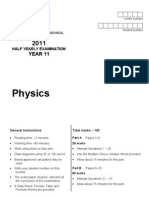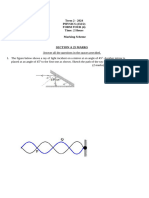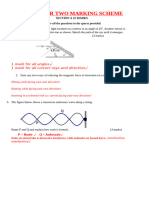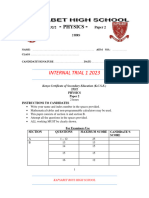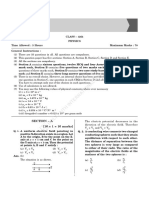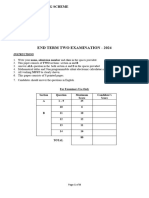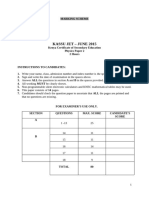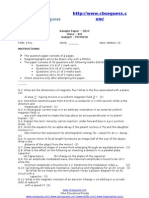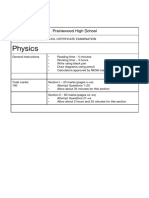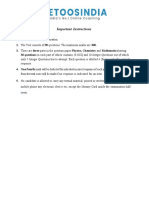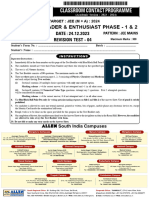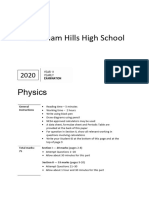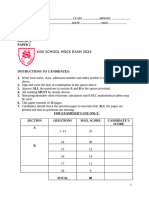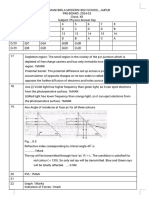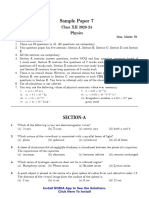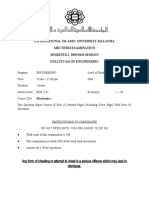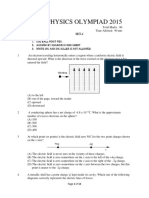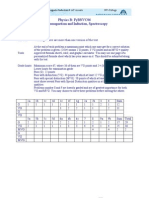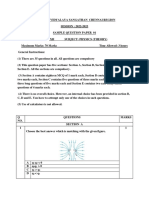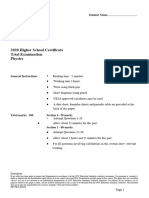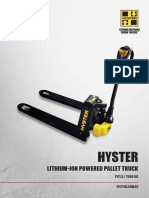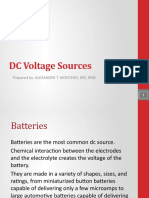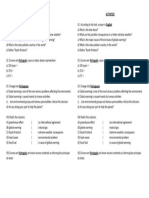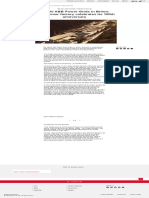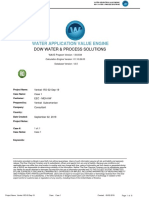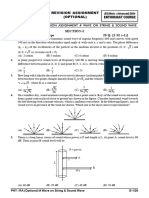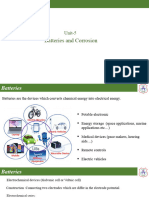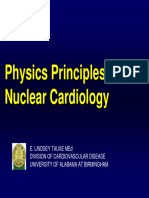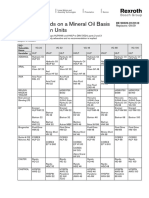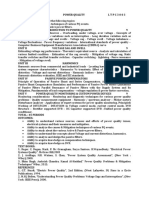Physics PP2 MS
Physics PP2 MS
Uploaded by
kibwanazainabCopyright:
Available Formats
Physics PP2 MS
Physics PP2 MS
Uploaded by
kibwanazainabOriginal Title
Copyright
Available Formats
Share this document
Did you find this document useful?
Is this content inappropriate?
Copyright:
Available Formats
Physics PP2 MS
Physics PP2 MS
Uploaded by
kibwanazainabCopyright:
Available Formats
Name: ………………………………………………….` Index No. ………………..
……
Candidates Sign: ……....…..…
Date: …………………………..
Kenya Certificate of Secondary Education (K.C.S.E)
PHYSICS
Paper 2
Time: 2 Hours
Instruction to Candidates
(a) Write your name, index number in the spaces provided above.
(b) Sign and write the date of examination in the spaces provided above.
(c) This paper consists of two sections: A and B.
(d) Answer all the questions in sections A and B in the spaces provided.
(e) All working must be clearly shown.
(f) Silent non-programmable electronic calculators may be used.
(g) Candidates should answer the questions in English.
For Examiners Use Only
Maximum Candidate’s
Section Question
Score Score
A 1 – 12 25
13 12
14 12
B 15 12
16 9
17 10
Total Score 80
This paper consists of 12 printed pages, candidate should check the questions to ascertain
that all pages are printed as indicated and that no questions are missing
©2023 KAPSABET BOYS 232/2 Page 1 of 12
HIGH
SECTION A 25 MARKS
Answer all the questions in the spaces provided.
1. The figure below shows a ray of light incident on a mirror at an angle of 45o. Another mirror
is placed at an angle of 45o to the first one as shown. Sketch the path of the ray until it
emerges. (2 marks)
1 mark for all angles
1 mark for all correct rays and direction
2. The figure below shows a transverse stationary wave along a string.
Name P and Q and explain how each is formed. (3 marks)
P – Node Q – Antinode
Nodes are formed due to destructive interference while antinodes are formed due to
constructive interference.
3. The diagrams below show a positively charged acetate strip and a negatively charged
polythene strip freely suspended and isolated.
Two rods X and Y are brought up in turn to these strips. X attracts the acetate strip but repels
the polythene strip. Rod X does not repel either the acetate or the polythene. State the type of
charge on
each rod.
X Negative charges (1 mark)
Y Neutral (1 mark)
©2023 KAPSABET BOYS 232/2 Page 2 of 12
HIGH
4. The figure below shows how magnets are stored in pairs with keepers at the end. Explain
how this method of storing helps in retaining magnetism longer (1 mark)
Keepers are magnetized through induction creating magnets with opposite polarity.
These creates loops through which magnetic field flows.
5. The diagram below shows waves generated from a tuning fork. If the wave takes 0.1 second
to move from point A to B. determine the frequency of the wave. (3 marks)
2.5 = 32
𝟏×𝟑𝟐
1=
𝟐.𝟓
𝝀 = 𝟏𝟐. 𝟖𝒎
𝟑𝟐
V= = 𝟑𝟐𝟎𝒎/𝒔
𝟎.𝟏
𝑽 𝟐.𝟓
f = = 𝟑𝟐𝟎 × =25Hz
𝝀 𝟑𝟐
6. In the figure 9 and 10 below, sketch a graph for each to show the variation of voltage with
time as displayed on a CRO screen. (2 marks)
The gaps must be equal
7. Other than current state two other factors that affect the magnitude of force on a current
carrying conductor placed in a magnetic field. (2 marks)
Length of the conductor within the magnetic field
Magnetic field strength
Angle between the conductor and magnetic field lines
©2023 KAPSABET BOYS 232/2 Page 3 of 12
HIGH
8. Concave mirrors are used by dentists to examine teeth. By use of a ray diagram show how
this is achieved. (2 marks)
1 mark for all correct rays and direction
1 mark for the virtual image.
9. A student connected the set up below in the laboratory. Explain the observation made on the
bulb when the set-up below is taken to a dark room (2 marks)
Brightness of the bulb increases.
The resistance of the LDR increases when the intensity of the light increases this causse
more current to flow through the bulb.
10. The figure below shows a fully charged capacitor
(i) State the observation made on the voltmeter when the switch is closed. (1 mark)
The reading decreases to zero.
(ii) State the function of resistor R (1 mark)
To increasing the time discharging. To slow down the rate of discharging by reducing
the amount of current flowing
©2023 KAPSABET BOYS 232/2 Page 4 of 12
HIGH
11. Calculate the maximum number of 100W bulbs that can be safely connected to 240V in a
circuit fitted with 13A fuse. (2 marks)
Power = VI
= 240×13
𝟐𝟒𝟎×𝟏𝟑
No. Of bulbs = 𝟏𝟎𝟎
= 31.20
= 31 bulbs
12. The figure below part of electromagnetic spectrum.
Identify radiation A and state its source. (2 marks)
Microwaves – Magnetrons/ Maser
©2023 KAPSABET BOYS 232/2 Page 5 of 12
HIGH
SECTION B 55 MARKS
Answer all the questions in this section in the spaces provided.
13. (a) The figure below shows a modern X-ray tube
(i) Name the part labelled C (1 mark)
Anode / copper anode (deny copper)
(ii) State the property of the material labelled B on the diagram which makes it suitable
for use in the X-ray tube. (1 marks)
High melting point
(iii) Why is C inclined at an angle of 45o? (1 mark)
To direct x rays out of the tube through the window
(iv) State the adjustment that can be made to vary
i. The quality of X-rays (1 mark)
Varying the accelerating voltage (increasing / decreasing the accelerating
voltage)
ii. The quantity of the X-rays. (1 mark)
Increasing or decreasing (varying) the heating current at the cathode
(v) Given that 99% of the energy of the electrons is converted into heat while the rest is
converted into x-rays, determine the frequency of the x-rays produced given that the
accelerating potential is 100KV (Plank’s constant = 6.63 x 10 -34 Js, e = 1.6x 10-19C)
(3 marks)
k.e = eV =hf
= 100000 × 1.6 × 𝟏𝟎−𝟏𝟗
= 1.6 × 𝟏𝟎−𝟏𝟒 J
𝒇 =2.413 ×𝟏𝟎𝟏𝟗 Hz
©2023 KAPSABET BOYS 232/2 Page 6 of 12
HIGH
(b) In a CRO, waveform given below was displayed on the screen when Y-shift was set at The
sensitivity at the Y plate was10V/cm andtime base set at 20 milliseconds/cm.
Determine:
(i) peak voltage (2 marks)
= y- gain ×no. of divisions
=10v/cm…× 2cm
= 20V
(ii) frequency of the signal (2 marks)
T. base = 𝟒 × 𝟐𝟎
= 𝟖𝟎𝒎𝒔
= 𝟎. 𝟎𝟖
𝟏
f= 𝟎.𝟎𝟖
=12.5 Hz
14. a) 226
88 decays into 222 �� by emission of an alpha particle. Write a nuclear equation
�� 86
for the decay (1 marks)
𝟐𝟑𝟖 𝟐𝟐𝟐
𝟖𝟖𝐑𝐚 𝟖𝟔𝐑𝐧 + 𝟒𝟐𝐇𝐞
b)
i) What do you understand by the term half-life of a radioactive substance? (1 mark)
Time taken by radioactive substance to decay to/by half of its original mass.
©2023 KAPSABET BOYS 232/2 Page 7 of 12
HIGH
ii) A G.M tube registers 20 counts. When a radioactive source is brought close to it, it
registers 3220 counts and 120 counts 30 hours later. What is the half-life of this
substance? (3 marks)
𝐼𝑛𝑖𝑡𝑖𝑎𝑙 = 3220 − 20
𝐹𝑖𝑛𝑎𝑙 = 120 − 20
30
1 𝑡
100 = 3200 ( )
2
30
5
1 1 𝑡
( ) =( )
2 2
30
5=
𝑡
𝑡 = 6 𝐻𝑜𝑢𝑟𝑠
c) The figure below shows a G.M tube.
Anode Aluminium casing
Mica window
Argon gas mixed
with little bromine
Scalar or ratemeter
i) What is the purpose of the mica window? (1 mark)
To allow all radiations to penetrate
ii) Explain the purpose of the bromine (2 mark)
To absorb k.e of the ions hence preventing secondary ionisation
iii) Why should argon gas be kept at low pressure (1 mark)
For easier ionization / for faster ionization
iv) What is meant by the term “dead time” as used in GM tube (1 mark)
Time taken by positive ions to move from anode to cathode
©2023 KAPSABET BOYS 232/2 Page 8 of 12
HIGH
v) Briefly explain how GM tube works. (2 marks)
When the radiations enters through the mica window, argon gas is ionized and the positive ions
move to the walls (cathode) as negative ions move to the anode. As the ions accelerate, they cause
further ionization (secondary ionization) leading to avalanche of electrons which enables pulse
current to flow and pulse voltage is registered across resistor R
15. (a) State the Ohms Law (1 mark)
Current flowing through a conductor is directly proportional to the p.d across its end and
provided that temperature and other physical conditions are kept constant.
(b) You are provided a rheostat, 2 cell, a voltmeter, an ammeter, a switch and a fixed resistor.
i) Draw a circuit diagram that can be used to verify Ohms law. (2 marks)
ii) Describe how the above set up can be used to determine Ohms law. (4 marks)
(i) Vary the voltage using the variable resistor and record the corresponding values of
voltage and current
(ii) Repeat for several values of current and voltage and tabulate
(iii) Plot a graph of P.d against current.
(iv) The graph is a straight line with positive gradient. Showing that current through a
conductor is directly proportional to the P.d across it.
©2023 KAPSABET BOYS 232/2 Page 9 of 12
HIGH
(c) Study the circuit diagram below and answer the questions that follow.
Calculate
(i) Determine the total resistance in the circuit. (2 marks)
𝑹𝟐 𝑹𝟏
𝑹 𝑻 = 𝑹𝟏 +
𝑹𝟐 + 𝑹𝟏
𝟖
= 1+
𝟔
= 2.333 Ω
(ii) The current through the 4Ω resistor (3 marks)
𝟏𝟐
𝐈𝐓 = 𝟐.𝟑𝟑𝟑 = 5.150A
P.D = IR=6.849V
𝐕 𝟔.𝟖𝟒𝟗
𝐈𝟒𝛀 = 𝐑 = 1.712A
𝟒
16. a) State Snell’s law (1mark)
The ratio of sine of angle of incidence to that of sine of angle of refraction is constant for
a given pair of medium
b) A ray of light travelling from water to glass makes an angle of incident of 300. Find the
angle of refraction in the glass. Refractive index of water = 4⁄3. Refractive index of glass
= 3⁄2 (3 marks)
𝐬𝐢𝐧 𝒊
= w ng
𝟎.𝟓
=
𝟗 r = 𝟐𝟔. 𝟑𝟗𝟎
𝐬𝐢𝐧 𝒓 𝐬𝐢𝐧 𝒓 𝟖
𝐬𝐢𝐧 𝟑𝟎 𝟑 𝟑 𝟖
= × Sin r =0.5 × 𝟗
𝐬𝐢𝐧 𝒓 𝟐 𝟒
c) State the necessary and sufficient conditions for total internal reflection to occur.
(2 marks)
1. Light must move from an optically denser to optically less dense medium.
2. The incidence angle in an optically denser medium must be greater than the critical
angle
©2023 KAPSABET BOYS 232/2 Page 10 of 12
HIGH
d) The figure below shows a human eye defect.
(i) State one possible cause of this defect. (1 mark)
Longer focal length
Shorter eyeball
(ii) On the diagram, show how the defect is corrected. (2 mark)
17. (a) State the Lenz’s law of electromagnetic induction. (1 mark)
The direction of induced e.m.f is such that the induced current that it causes to flow
produces a magnetic effect which opposes the charge producing it
(b) A bar magnet is moved into a coil of an insulated copper wire connected to a zero
centre galvanometer as shown below
(i) Show on the figure above the direction of the induced current in the coil
(1 mark)
(ii) State and explain what is observed on the galvanometer when the south pole of the
magnet is moved into and then withdrawn from the coil. (2 marks)
The pointer deflects in one direction and comes back to zero. When magnetic fields cut
through the conductor, emf is induced which makes the current to flow and the pointer
deflect but comes back to zero when there is no relative motion between the coil and the
magnet
©2023 KAPSABET BOYS 232/2 Page 11 of 12
HIGH
(c) A transformer has 800 turns in the primary and 40 turns in the secondary winding.
The alternating voltage connected to the primary is 240V and current of 0.5.A. If 10%
of the power is dissipated as heat within the transformer, determine the current in the
secondary coil.
(3 marks)
𝑵𝑮 𝑽𝑺
=
𝑵𝑷 𝑽𝑷
𝟒𝟎 𝑽𝑺
= 𝟐𝟒𝟎
𝟖𝟎𝟎
𝟒𝟎+𝟐𝟒𝟎
𝑽𝑺 = = 12V
𝟖𝟎𝟎
𝐕𝐒 𝐈𝐒
× 100 = 90
𝐕𝐏 𝐈𝐏
𝟎.𝟗 ×𝟐𝟒𝟎 ×𝟎.𝟓
𝐈𝐒 = =9A
𝟏𝟐
(d) The diagram below shows a three-pin plug.
(i) Name the colour of conductors P and Q (2 marks)
P - Blue / Black
Q – Red / Brown
(ii) Why is the earth pin longer than the rest in the three-pin plug shown above?
(1 mark)
To open the blinds
To earth the appliance before current start flowing
©2023 KAPSABET BOYS 232/2 Page 12 of 12
HIGH
You might also like
- Kenya - FNRB Report - GS 10792Document17 pagesKenya - FNRB Report - GS 10792Dr. Vikas Vatsa100% (1)
- Year 11 Physics HY 2011Document20 pagesYear 11 Physics HY 2011Larry MaiNo ratings yet
- Physics Paper 2 - Marking SchemeDocument12 pagesPhysics Paper 2 - Marking SchemekiruhuravaleryNo ratings yet
- Physics P2 KassuDocument15 pagesPhysics P2 KassumumbisueNo ratings yet
- Phyc F4 PP2 MSDocument11 pagesPhyc F4 PP2 MSMUSA MOHAMEDNo ratings yet
- 2022-2023G Fiz102E 2vDocument2 pages2022-2023G Fiz102E 2vesinyvsNo ratings yet
- Phy PP2 QSDocument17 pagesPhy PP2 QSKELVINNo ratings yet
- Physics p2 QPDocument16 pagesPhysics p2 QPsamsonlacazette7No ratings yet
- Physics Paper 2 Questions 2Document12 pagesPhysics Paper 2 Questions 2Daniel Musyioki MutuaNo ratings yet
- Physics Form 4 Opener PP2 QDocument13 pagesPhysics Form 4 Opener PP2 QElijah KirigaNo ratings yet
- Physics XII Sample PaperDocument16 pagesPhysics XII Sample Paperrohit.moni2007No ratings yet
- Phy F3 Et2 PP2 MSDocument8 pagesPhy F3 Et2 PP2 MSbettabuu1No ratings yet
- BSC II Year - Physics Paper-II - 2017Document3 pagesBSC II Year - Physics Paper-II - 2017Tharun TharunNo ratings yet
- Mock Advanced Test-8 Paper-1: TIME: 3 Hrs M.M.: 180Document18 pagesMock Advanced Test-8 Paper-1: TIME: 3 Hrs M.M.: 180mail2sgarg_841221144No ratings yet
- QP CODE: 23123528: Reg No: NameDocument2 pagesQP CODE: 23123528: Reg No: Nameathulyabiju331No ratings yet
- Phys P2 - M.SDocument15 pagesPhys P2 - M.SnamelessmsaniiNo ratings yet
- Qns_ANTS-CPT#01(Dropper Medical)_01-12-2024Document40 pagesQns_ANTS-CPT#01(Dropper Medical)_01-12-2024ongrindemodeNo ratings yet
- Sample Paper - 2012 Class - XII Subject - PHYSICSDocument5 pagesSample Paper - 2012 Class - XII Subject - PHYSICSAnirudh MuraliNo ratings yet
- GR10 Physical Sciences Examplar ExaminationDocument24 pagesGR10 Physical Sciences Examplar Examinationhlumelompingololo048No ratings yet
- Cblephpu 20Document6 pagesCblephpu 20Mahadev SharmaNo ratings yet
- 2020 PHY - PHS - Trial Paper (Without Solutions)Document29 pages2020 PHY - PHS - Trial Paper (Without Solutions)Praveena PeterNo ratings yet
- Paper - 1Document23 pagesPaper - 1Sunil KumarNo ratings yet
- PHYSICS 2 Mangu High KCSE 2023 MocksDocument13 pagesPHYSICS 2 Mangu High KCSE 2023 Mocksgatrinrioba857No ratings yet
- 9397physics Paper 2 (2012) With SolutionsDocument5 pages9397physics Paper 2 (2012) With SolutionsdannycbsNo ratings yet
- Sample Test Term 1 QP Xii 2020 SeptDocument9 pagesSample Test Term 1 QP Xii 2020 SeptEdwinNo ratings yet
- 2022 WA3 Science (Physics) 3E ModifiedDocument11 pages2022 WA3 Science (Physics) 3E ModifiedfinNo ratings yet
- 12 Phy Home Test 3Document18 pages12 Phy Home Test 3vpgokul58No ratings yet
- Model Exam Ii - 2 - 09022024 - 155303Document6 pagesModel Exam Ii - 2 - 09022024 - 155303Sangeeth Manoj KumarNo ratings yet
- Final Model Paper Physics SSC-II RevisedDocument7 pagesFinal Model Paper Physics SSC-II Revisedfuntimemasti947No ratings yet
- Important InstructionsDocument16 pagesImportant Instructionssagnik debnathNo ratings yet
- Allen Mains 24-12-23 QP & SolDocument25 pagesAllen Mains 24-12-23 QP & Solsmhsyasirahmad10a.51No ratings yet
- Physics Class Xii Sample Paper Test 12 For Board Exam 2024Document5 pagesPhysics Class Xii Sample Paper Test 12 For Board Exam 2024xkryxxzNo ratings yet
- Phy-QP-2Document6 pagesPhy-QP-2sayanthseoNo ratings yet
- Physics Class Xii Sample Paper Test 03 For Board Exam 2024Document6 pagesPhysics Class Xii Sample Paper Test 03 For Board Exam 2024xkryxxzNo ratings yet
- Electronics Past Test Questions and MemoDocument22 pagesElectronics Past Test Questions and MemoPrevin BogopaNo ratings yet
- Baulkham Hills 2020 Physics Prelim Yearly & SolutionsDocument30 pagesBaulkham Hills 2020 Physics Prelim Yearly & SolutionsTharanga MudaligeNo ratings yet
- Phys P2Document12 pagesPhys P2Fatma HusseinNo ratings yet
- General 250 1586564070Document12 pagesGeneral 250 1586564070Abitekaniza HassanNo ratings yet
- Answer Key XII Phy Paper PB 2024-25Document5 pagesAnswer Key XII Phy Paper PB 2024-25yasothasathiya696No ratings yet
- Class 12 Physics QP PB-I (1)Document9 pagesClass 12 Physics QP PB-I (1)arpithamajith123No ratings yet
- Sample Paper 7: Class XII 2023-24 PhysicsDocument6 pagesSample Paper 7: Class XII 2023-24 PhysicsBhaviniNo ratings yet
- Ece1231 Mid Term SolnDocument10 pagesEce1231 Mid Term SolnOppa Sollehudin SapariNo ratings yet
- Grade XII Physics Olympiad Set IDocument14 pagesGrade XII Physics Olympiad Set IHabiba Ali SalahNo ratings yet
- Test+FyBCh20 21NVC06+Magnetic+Induction+&+AC+CircuitsDocument7 pagesTest+FyBCh20 21NVC06+Magnetic+Induction+&+AC+CircuitsEpic WinNo ratings yet
- Final Exam 259 Answer KeyDocument20 pagesFinal Exam 259 Answer KeyYasmeenNo ratings yet
- National University of Singapore: PC1222 Fundamentals of Physics IIDocument11 pagesNational University of Singapore: PC1222 Fundamentals of Physics IIYuhua SunNo ratings yet
- PHYSICS Xii PB-1 QPDocument10 pagesPHYSICS Xii PB-1 QPAyaan HusainNo ratings yet
- UK Dist II PU Physics QP Midterm-2024Document2 pagesUK Dist II PU Physics QP Midterm-2024shuaib9448No ratings yet
- Mangu Paper 2Document12 pagesMangu Paper 2bllyr254No ratings yet
- Grade 12 - Physics PB2Document9 pagesGrade 12 - Physics PB2Nazneen AliNo ratings yet
- Assessment Physics PaperDocument6 pagesAssessment Physics PaperPradeesh GNo ratings yet
- PB XII Phy QP Nov 2022Document8 pagesPB XII Phy QP Nov 2022Ayushi KayalNo ratings yet
- QP_PHYSICS_XII_I PBDocument8 pagesQP_PHYSICS_XII_I PBhiteshbarik2007No ratings yet
- Xii Phy Sample Question Paper 01Document9 pagesXii Phy Sample Question Paper 01Aman DhamiNo ratings yet
- Question Paper Physics PB I 2023-24Document6 pagesQuestion Paper Physics PB I 2023-24rishirajkaran2006No ratings yet
- XII_PHY_PB1_QP_SET ADocument8 pagesXII_PHY_PB1_QP_SET Asiddharth sasidharanNo ratings yet
- Phytr20 ExamDocument27 pagesPhytr20 Examyupinma360No ratings yet
- O level Physics Questions And Answer Practice Papers 2From EverandO level Physics Questions And Answer Practice Papers 2Rating: 5 out of 5 stars5/5 (1)
- O level Physics Questions And Answer Practice Papers 1From EverandO level Physics Questions And Answer Practice Papers 1Rating: 3.5 out of 5 stars3.5/5 (4)
- Difference Beteen EMF and Potential DifferenceDocument3 pagesDifference Beteen EMF and Potential DifferenceDavidNo ratings yet
- Sabp P 060Document22 pagesSabp P 060Hassan Mokhtar100% (1)
- 1.1.about The SubstationDocument4 pages1.1.about The Substationkiran_gill_2No ratings yet
- Hyster: Lithium-Ion Powered Pallet TruckDocument3 pagesHyster: Lithium-Ion Powered Pallet TruckAlbertoNo ratings yet
- Chapter 15Document132 pagesChapter 15syed afhamNo ratings yet
- DC Voltage Sources: Prepared By: Alexander T. Montero, Ree, RmeDocument12 pagesDC Voltage Sources: Prepared By: Alexander T. Montero, Ree, RmeMarc Jairro GajudoNo ratings yet
- 2 - Wan Chai 5Document3 pages2 - Wan Chai 5Usman ANo ratings yet
- Karta Katalogowa Intelight VellaDocument6 pagesKarta Katalogowa Intelight VellaRazvan NedelescuNo ratings yet
- Rajasthan Refinery Project Pachpadra, Rajasthan, India Epcc-8 Package (Lldpe/Hdpe Swing Unit)Document1 pageRajasthan Refinery Project Pachpadra, Rajasthan, India Epcc-8 Package (Lldpe/Hdpe Swing Unit)Carlos MartinezNo ratings yet
- Properties of Sunlight - Part IDocument50 pagesProperties of Sunlight - Part IchesterpetersNo ratings yet
- Activities - Global WarmingDocument1 pageActivities - Global WarmingValéria Ribeiro MartinsNo ratings yet
- Hitachi ABB Power Grids in Brilon - Transformer Factory Celebrates Its 100th AnniversaryDocument1 pageHitachi ABB Power Grids in Brilon - Transformer Factory Celebrates Its 100th AnniversarychipulinoNo ratings yet
- Civil Eng Bfe6b321Document8 pagesCivil Eng Bfe6b321AnjaliNo ratings yet
- MEW RO WaveDocument8 pagesMEW RO Wavetsvs58No ratings yet
- 50 Great Ways The Maritime Industry Could Reduce Its Greenhouse Gas Emissions Wartsila EbookDocument13 pages50 Great Ways The Maritime Industry Could Reduce Its Greenhouse Gas Emissions Wartsila EbookSaijay ShirodkarNo ratings yet
- SattconPCB LT1071CTDocument13 pagesSattconPCB LT1071CTming8731No ratings yet
- 01 - Assignment # Wave On String & Sound Wave - EngDocument20 pages01 - Assignment # Wave On String & Sound Wave - Engashutoshpradhanyt666No ratings yet
- Correos ElectrónicosDocument318 pagesCorreos ElectrónicosEDUARDO JOSE MENDOZA ARMENTANo ratings yet
- STR 155 Specs Sheet MarkDocument7 pagesSTR 155 Specs Sheet MarkSantiago Sangil SanchezNo ratings yet
- Y10 May 2021 GL PrepDocument52 pagesY10 May 2021 GL PrepFatma SharifNo ratings yet
- 6-FMXH-100B Shoto High Temperature BatteriesDocument2 pages6-FMXH-100B Shoto High Temperature BatteriesEric OukoNo ratings yet
- Suroso Isnandar PLN Sulawesi Ketua Tim Pengembangan PLTN PLNDocument26 pagesSuroso Isnandar PLN Sulawesi Ketua Tim Pengembangan PLTN PLNarif abidinNo ratings yet
- Batteries and Corrosion-IDocument39 pagesBatteries and Corrosion-IRavi KumarNo ratings yet
- 01 Tauxe - Basic Physics Principles For Nuclear CardiologyDocument55 pages01 Tauxe - Basic Physics Principles For Nuclear CardiologyemhufafNo ratings yet
- Équivalences D'huiles - Fluides Hydrauliques Des Différentes MarquesDocument8 pagesÉquivalences D'huiles - Fluides Hydrauliques Des Différentes Marquesyassineguenfoud412No ratings yet
- EE8006-POWER QUALITY SyllabusDocument1 pageEE8006-POWER QUALITY SyllabuskarthikadevikNo ratings yet
- 10DAIHATSU3cyl850D 26hp SparepartsDocument22 pages10DAIHATSU3cyl850D 26hp SparepartsRobertJansenNo ratings yet
- CDM CDMF 60Hz CatalogDocument56 pagesCDM CDMF 60Hz CatalogVincent Ely MarNo ratings yet
- Force and Momentum - QuizizzDocument15 pagesForce and Momentum - QuizizzHarry ChaoNo ratings yet

